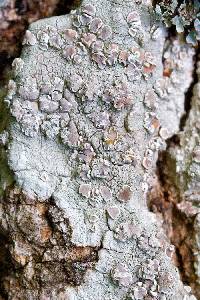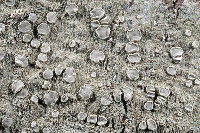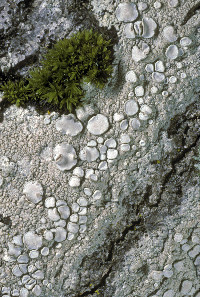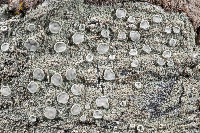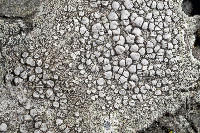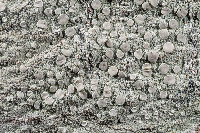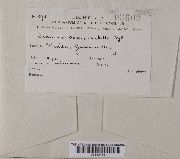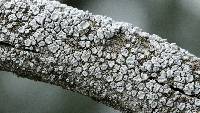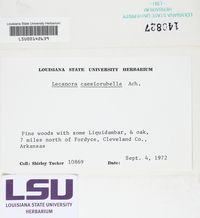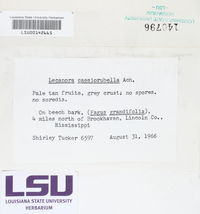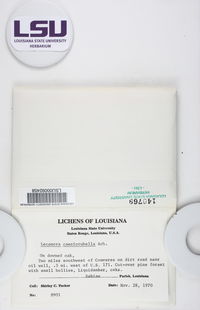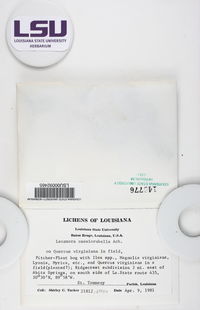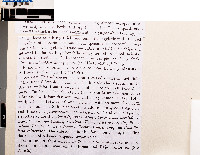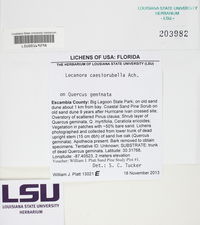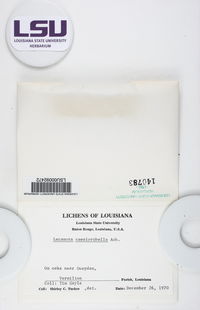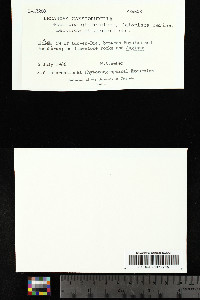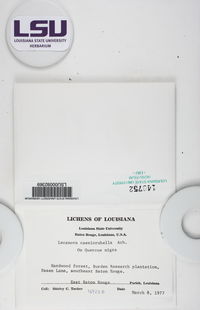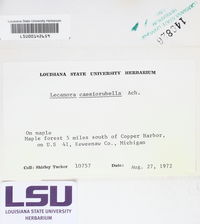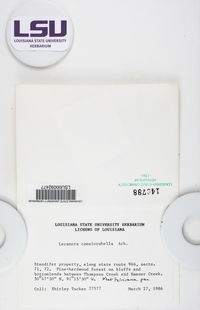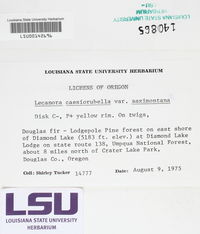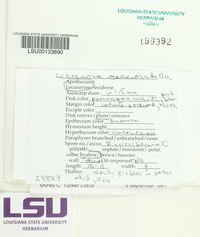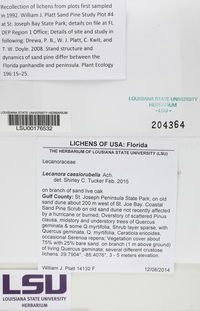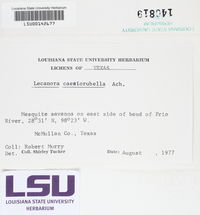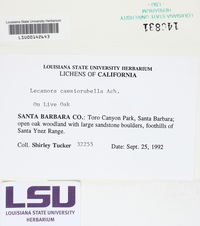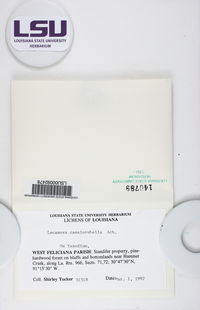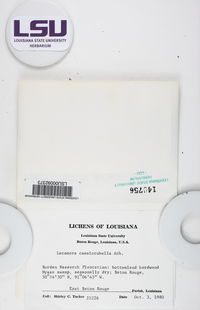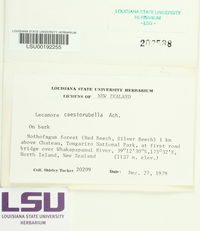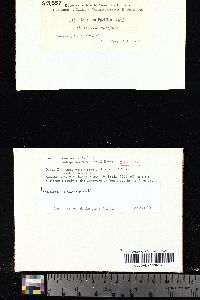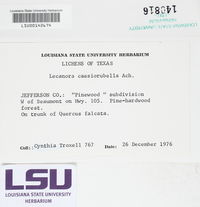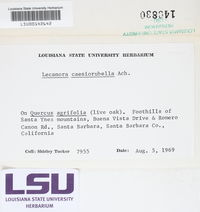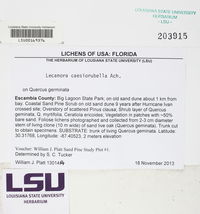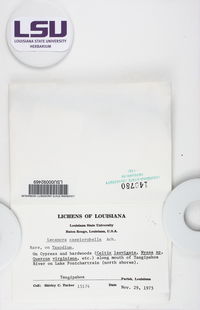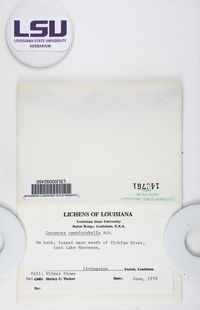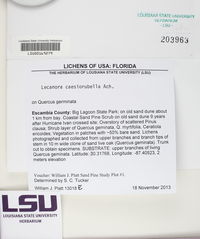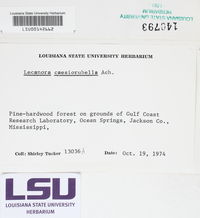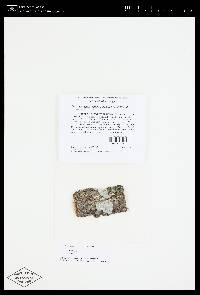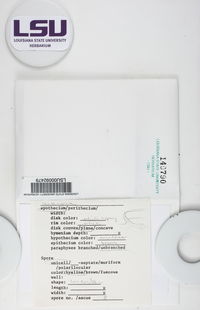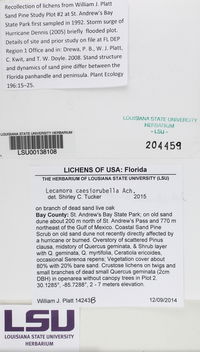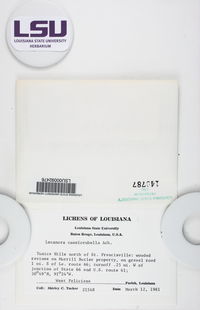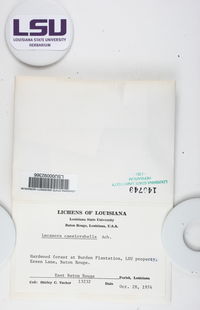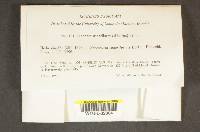
- Home
- Search
- Images
- Species Checklists
- US States: O-Z >
- US National Parks
- Central America
- South America
- US National Parks
- Southern Subpolar Region
|
|
|
|
Family: Lecanoraceae
[Lecanora australiensis Zahlbr., moreLecanora caesiorubella subsp. caesiorubella Ach., Lecanora cancriformis (Hoffm.) Vain., Lecanora leucoma Nyl., Lecanora pallida var. caesiorubella (Ach.) H. Magn., Lecanora pulverata Stirt., Parmelia caesiorubella (Ach.) Fr., Patellaria caesiorubella (Ach.) Trevis., Verrucaria cancriformis Hoffm.] |
MycoBank no. 356369 Type: North America, exact locality unknown, original label data: “habitat in cortice arborum Americae septentrionalis”, sine dato, Swartz, O.P. s.n. [UPS-ACH 644–syntype; no lectotype designated by Brodo (1966) or Lumbsch et al. (1997)]. Description. Thallus corticolous, moderately thickened, continuous to rimose-areolate to verruculose areolate; surface whitish gray to grayish green (becoming beige with prolonged storage in the herbarium), smooth, epruinose, lacking soredia; prothallus whitish, arachnoid or forming a compact, whitish line, occasionally indistinct. Apothecia sparse to numerous, circular or slightly undulate in outline, 0.8–3 mm in diam., sessile, distinctly lecanorine with a smooth, epruinose, persistent, prominent thalline margin concolorous with the thallus; disc plane to weakly convex, pale yellowish beige to pinkish or pale carneous, densely whitish pruinose; hymenium hyaline, not inspersed, epihymenium with a diffuse, dull brown pigment (elachista-brown: dissolving in K, HCl± dull greenish, N−) and few to abundant minute crystals, mostly dissolving in K (residue of fine, rounded, reddish granules persistent, 0.5–1 μm); proper exciple thin, indistinct, with few minute crystals; thalline exciple thick, of thin-walled, radiating hyphae with numerous, but inconspicuous photobiont cells obscured from abundant small crystals dissolving in K, ecorticate or indistinctly corticate (outer cells darker brown); hypothecium hyaline; ascospores 8/ascus, simple, broadly ellipsoid or subglobose, (5.0−)7.7−10.5(−11.9) × (4.0−)5.5−7.2(−7.9) μm (n = 45). Pycnidia not seen. Chemistry. Thallus cortex including apothecial margin P+ orange-red, C−, KC−, K+ yellow, UV− (pale yellow); with atranorin [major], protocetraric acid [major], ±lichesterinic acid [minor]; [specimens analyzed with TLC: Bungartz, F. 4466 (CDS 28552), 6225 (CDS 28552), 6254 (CDS 34466), 6316 (CDS 34531), 6348 (CDS 34563), 7441 (CDS 37928), 7845 (CDS 38354); Simbaña, W. 537 (CDS 32373); Weber, W.A. s.n. (L-62866, COLO 294655)]. Ecology and distribution. Pantropical (North and South America, Africa, Asia, Australia and Oceania); a very common corticolous species in the Galapagos, from the coastal through the dry into the transition zone, typically in open, sunny and exposed habitats, frequent on small trees and shrubs like Bursera, Croton, Psidium, and Piscidia, Notes. Imshaug & Brodo (1966) distinguished five subspecies of L. caesiorubella, by chemical and distributional differences. Lumbsch et al. (1997) accepted L. caesiorubella ssp. lathamii Imshaug & Brodo at species level as L. subpallida Zahlbr., but found more complex patterns of chemical variation, which they regarded inconsistent with the subspecies concepts of Imshaug & Brodo (1966). None of the authors selected a lectotype. Since the species in its broad circumscription is widespread and the designation of a lectotype could have far-reaching consequences for the naming of chemotypes and subspecies we prefer not to designate a lectotype here either. All Galapagos specimens contain atranorin and protocetraric acid but no virensic acid. These collections would therefore belong to L. caesiorubella ssp. glaucomodes in the sense of Brodo et al. (2019) or chemotype II sensu Lumbsch et al. (1997). The occurrence of the aliphatic lichesterinic acid in some of the collections from Galapagos suggests that these specimens constitute a hitherto unrecognized chemotype. However, Brodo et al. (2019) recently reported the occurrence of roccellic and nephrosteranic acids (aliphatic acids as well) in L. caesiorubella ssp. glaucomodes and ssp. saximontana. In light of the unresolved taxonomy and apparently complex chemistry of the group as well as lack of molecular data we prefer to keep the specimens under L. caesiorubella “s.l.” for the time being. Nash, T.H., Ryan, B.D., Gries, C., Bungartz, F., (eds.) 2004. Lichen Flora of the Greater Sonoran Desert Region. Vol 2. Thallus: crustose, continuous or rimose-areolate or verrucose areolate; prothallus: not visible, or white areoles: flat or verruculose, thin or thick, opaque, ecorticate surface: whitish gray to gray or pale green to greenish white, smooth, epruinose, with an indistinct margin or arachnoid, esorediate Apothecia: sessile, 0.8-3 mm in diam., leca disc: orange-brown or pinkish to carneous, plane or convex, heavily whitish gray pruinose margin: concolorous with thallus, thick, persistent, prominent, entire or flexuose, smooth, entire, without a parathecial ring amphithecium: present, with numerous algal cells, with numerous small crystals which dissolve in K, 70-180 µm thick, corticate or not; cortex: absent or indistinct, hyaline, basally not thickened, interspersed, (45-)75-95(-100) µm thick laterally, (50-)55-80(-105) µm thick basally parathecium: hyaline, containing crystals insoluble in K epihymenium: brown to dark brown, with pigment dissolving in K, with crystals dissolving in K hymenium: hyaline, clear; paraphyses: slightly thickened (up to 2.5 µm wide) apically, not pigmented; subhymenium: hyaline, 15-20 µm thick; hypothecium: hyaline, without oil droplets asci: clavate, 8-spored ascospores: hyaline, simple, ellipsoid or broadly ellipsoid, (9-)12.5-15(-15.5) x (5-)5.5-7.5(-9.5) µm; wall: less than 1 µm thick Pycnidia: not seen Spot tests: K+ yellow or yellow turning red, C-, KC-, P+ orange to red Secondary metabolites: atranorin (major), chlonorine roatranorin (minor), connorstictic acid (minor or absent), conprotocetraric acid (minor or absent), norstictic acid (major or absent), protocetraric acid (major or absent), salazinic acid (minor or absent), stictic acid (minor or absent) and virensic acid (major, minor or absent). Substrate and ecology: on bark mostly of deciduous and evergreen angiosperm trees and conifers in lowland and montane regions World distribution: pantropical, known from Africa, Asia, Australasia, North America, South America, and the Pacific Area Sonoran distribution: Arizona, southern California, Baja California, Baja California Sur, Chihuahua, Sinaloa, and Sonora. Notes: Lecanora caesiorubella is characterized by rather large apothecia with heavily pruinose disc and thick, flexuose margins. It may be difficult to separate from L. albella. The differences of both species are discussed under L. albella. The chemistry of L. caesiorubella is extremely variable. With regard to the chemistry, Imshaug & Brodo (1966) distinguished five subspecies. Subsequently, the chemical variation was found to be more complex (Lumbsch et al. 1997) and intermediate specimens were found. Hence, We prefer not to regard the chemical variation at any taxonomic rank. In the greater Sonoran Desert region, the chemotype containing the norstictic and protocetraric acid chemosyndromes in addition to atranorin is most common. |
|
|
|





